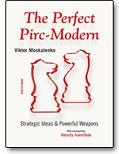 |
Book Reviews |
Last updated 1 July 2013

| index |
The Perfect Pirc-Modern

by Viktor Moskalenko
Good day! In this issue I’m starting what hopefully will become a regular series of book reviews. Whilst I’m maybe not the best qualified person to provide this, I remain something of a technophobe and so I do buy lots of chess books, spending quite a lot of time browsing through them. So, despite my shortcomings, I shall happily share my opinions on some of these!
My first selection is the fairly recent “The Perfect Pirc-Modern” by the Ukrainian Spanish-based GM Viktor Moskalenko (pictured below); New in Chess, 2013 – another openings book, I hear you groan!
The book’s contents are what it says on the tin – a survey of these 2 closely related opening complexes, the Pirc 1.e4 Nf6 2.d4 Nf6 3.Nc3 g6 and the Modern 1.e4 d6 2.d4 g6 3.Nc3 Bg7 Both are dynamic combative openings leading to lively complex middle-games – those seeking a quiet life should look elsewhere. Moskalenko is the accomplished author of the widely acclaimed “The Flexible French”, “Revolutionize your Chess” and “The Wonderful Winawer” and the book follows the welcome modern trend of providing a selection of heavily annotated games containing lucid explanations of ideas, plans and pitfalls for both sides rather than the old style of simply presenting a huge myriad of variations with little in the way of explanation (the phrase “database dump” comes to mind).
Moskalenko has a relaxed easy-to read style, interspersing his annotations with short highlighted sections titled either “Trick” or “Weapon” which help explain what’s going on. For me the book is almost like visiting an old friend as I regularly employed this opening complex in over-the-board play in the 70’s and 80’s and, whilst the book doesn’t claim to be an exhaustive study of the openings, it does provide an excellent review of selective lines.
Almost as expected, the book presents the main lines from White’s perspective in a series of chapters (seven in all) in its 240 or so pages. Rather surprisingly two chapters and almost half of the book are devoted to the so-called “Austrian Attack” popularised by Fischer where White plays 4.f4 in search of a quick knock-out. I say surprising as the Austrian is not nearly as popular as it once was – provided Black knows what he’s about there are several lines which, although dangerous, offer good counter attacking chances.
The author provides in-depth cover of all Black’s options including my favourite, the rather risky 1.e4 d6 2.d4 Nf6 3.Nc3 g6 4.f4 Bg7 5.Nf3 O-O 6.Bd3 Na6!?
The popularity of the Austrian declined gradually from the 80’s onwards as players began to appreciate that, rather than permit Black counter-chances, it was safer and more effective for White to simply develop pieces behind the d4 and e4 pawns and await developments – Karpov’s successes with this plan were also influential!

Here the author provides detailed coverage of Black’s options after the main line 1.e4 d6 2.d4 Nf6 3.Nc3 g6 4.Nf3 Bg7 5.Be2 O-O 6.O-O but omits the liveliest line with 6…. c6 concentrating instead on the solid 6… Bg4 and the quiet 6…. Nc6 Other chapters are devoted to White’s other main options, the dangerous 4.Bg5, the quiet 4.g3 and the currently very popular 4.Be3 which often leads to the so-called “150 Attack” where White often follows up with Bd3, Nf3 and Qd2. Here the author presents a strong case for Kramnik’s favourite 1.e4 d6 2.d4 Nf6 3.Nc3 g6 4.Be3 a6!? but omits any mention of the line used very successfully by Colin McNab for whom the Pirc/Modern has been the mainstay of his repertoire throughout his entire career 4.Be3 Bg7 5.Nf3 c6 6.Qd2 Qa5
My only possible criticism of this book is that maybe less space should have been devoted to the Austrian (half the book!) and more to the alternatives Black may have to face. In the Pirc, White’s attacking 1.e4 d6 2.d4 Nf6 3.Nc3 g6 4.Bc4 barely gets a mention and I could find nothing at all on the dangerous (I know this to my cost!) 1.e4 d6 2.d4 Nf6 3.Nc3 g6 4.Be2 Bg7 5.h4!? Similarly in the Modern the line 1.e4 d6 2.d4 g6 3.c3 has scant coverage whilst those wondering about the alternative here of 3.c4 are advised to refer to another book by another author!
However, any serious criticism of this work in which the author’s enthusiasm and energy are transparent would be unwarranted. For some reason both the Pirc (barely 1% of the games in my corr. database of some 1.25 million games) and the Modern (2.5%) have never been popular in correspondence play.
Hopefully this book, which I warmly recommend, will go at least a little way towards rectifying the situation!